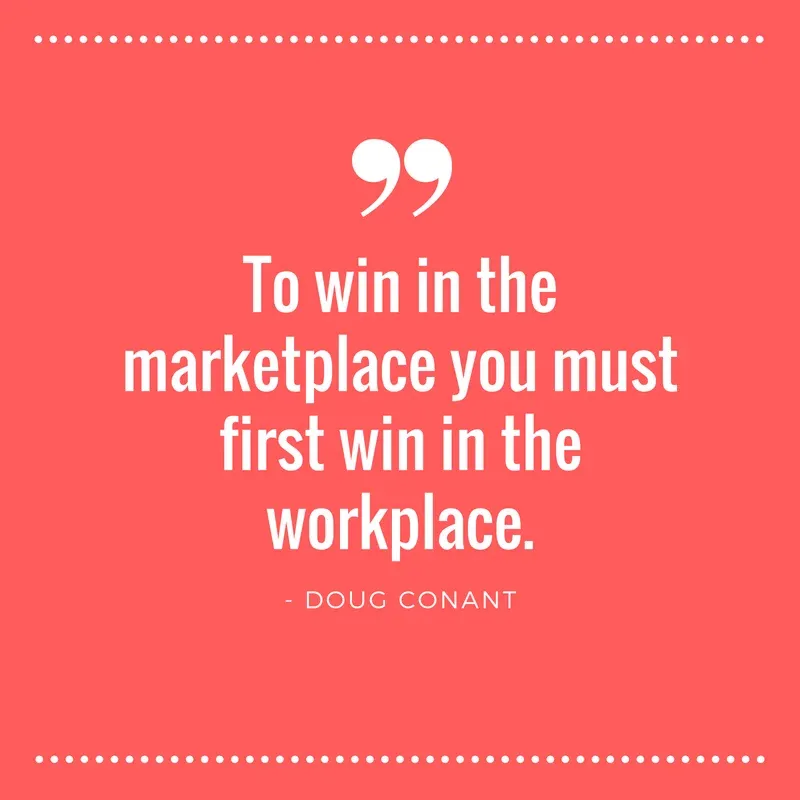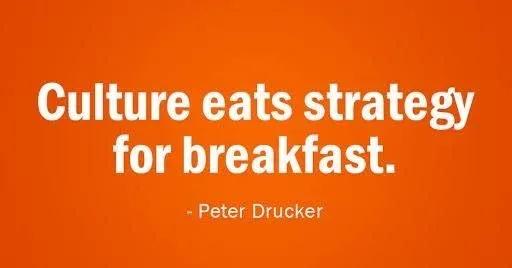Culture vs Engagement: What is the Difference?

According to Deloitte
- Companies that proactively manage culture demonstrate, on average, a 516% higher revenue growth than those who do not - over a 10 year period.
- Organizations that actively manage their culture typically have 30% higher levels of innovation and 40% higher levels of retention.
- Companies with a highly engaged workforce outperform their peers by 147% in earnings per share, and their employees are 87% less likely to leave.
- “Mission-driven” companies are more poised for success.

According to Gallup, Highly engaged employees are 21% more productive.
And finally, we have the famous line, that gets quoted in nearly every meeting…

YET.
We continue to get culture and employee engagement mixed up? Interchanging them glibly on zoom talks. Measuring one when we should be tracking the other. To be fair, the confusion is understandable.
Most literature, talk shows and media tend to use culture and engagement in the same breath. Which is both puzzling and sad. Puzzling, because it betrays an inscrutable lack of vision and intent on the part of leaders to understand the two concepts that impact business outcomes. Sad, because having more clarity can lead to far more profitable decisions and happier teams.
So let’s try to separate oil, from what-looks-like-oil, one more time - shall we?
Different between culture and engagement: This vs that
Let's get the basics out of the way.
Culture decides
- Values
- Vision
- Mission
- Attitudes
- Behaviour
- Innovation & Creativity
- Aggressiveness
- Agility
- Stability
- Hiring & Retention
- Diversity & Equal opportunity
- Brand equity
- Social consciousness
Engagement decides
- Morale & Happiness
- Mental health
- Communication & Feedback
- Collaboration
- Relationships
- Performance
- Profitability
- Rewards & Recognition
- Job satisfaction
- Customer goodwill
- Value
Culture is the superset, engagement is the subset
Culture reflects your big WHY and embodies your big organizational purpose. Consider it a ‘context’ and ‘bedrock’ of values, attitudinal codes and behavioural rituals that tell a new joinee what you stand for and “how things get done around here”.
Engagement is how excited newcomers feel about the whole thing, the extent of the approval and involvement they display towards it, and by extension, the job satisfaction and role fulfilment they derive from your ‘culture experience’, every day.
Let’s take a quick look at some of the many points of view (including some offbeat and quirky takes) that attempt to differentiate between company culture and employee engagement.
1. Whole vs part
Engagement measures the individual moods of different employees, while culture is more a statement on the collective organizational sentiment and leadership.
2. Who you are vs how you express it
Culture is your organization’s sense of self-identity and self-worth. But you also need to articulate it clearly, so that your ecosystem understands exactly what that is.
Explain to the world what you mean by the word ‘culture’ by laying down enabling ecosystems and designing empowering frameworks that make it easy for employees to behave in a way you want them to, and in a manner that resonates with your ‘personal definition’ of culture – thus furthering business goals while optimizing individual abilities and finding reasons of fulfilment at work.
3. Input vs output
Culture is the mixture of values, morals and approaches you feed into the machine. How your employees interpret, internalize and reinvent them (‘their way’) to add meaning to their work and life - all the while adding colour, warmth and buzz to the workplace - is engagement.
4. Theory vs lab
Culture is the big fat textbook. It’s important - all action needs the validating premise of logic and rationale - but unless you ‘play’ and experiment with it in the real-life setting of your workplaces (‘labs’), you won’t arrive at the right fit, or even know if it’s a practical enough idea to be practised on a daily basis.
5. Idea vs reality
Culture exists as an idea, till engagement makes it real. You can think (and, sometimes, overthink) about culture, discuss it in the boardroom, and have HR capture it in a policy page, but it will remain a figment of your imagination until you bring it to life through behaviour-influencing channels and actions (such as free feedback loops, friendly nudges, helpful alerts, gamified competition and real-time coaching) which your employees can identify with, participate in and go on to champion on both internal and external forums.
This not only gives employees a feeling of your philosophy, but also delivers Proof of Concept (convincing the world that your culture strategy actually ‘works’), lets your teams align, adjust and get comfortable with its core ethos, and helps you fine-tune the experience iteratively.
Culture is the dough. engagement is the pastry you make of it.
Those pastries may come in different shapes and sizes (depending on how creative you feel like a chef on that particular day), but they will all have a familiar aftertaste - because they are born of the same parent. Remove the dough, and there are no more pastries.
Culture is your election campaign plank. Engagement is an indication of whether you'll become president.
Culture announces to the world your big beliefs, your vision of how the world should be, and the lengths you are willing to travel to get there.
Engagement is whether the crowd likes what they see and hear, whether they are willing to take a chance on you, and the various signals, gestures and behaviours they spontaneously and repeatedly practise to show their solidarity and endorsement of your cause.
How does culture impact engagement?
Company Culture and employee engagement are closely related. When culture lays down the ‘rules of the game’, so to speak, it becomes easier for employees and workers to understand what they are working towards and what is expected of them.
As a consequence, they feel more involved, connected and engaged. Result? The daily workday brings less friction and confusion, and more clarity, happiness and productivity.
Want to strengthen employee engagement? Nurture the culture
You cannot build the superstructure without strengthening the foundation. To engage your employees at work, focus on erecting robust culture pillars and keeping a doting eye on them.
Culture is a living and breathing thing that changes with shifting expectations of markets and stakeholders and should, ideally, have a strong symbiotic relationship and interactive resonance with both:
(A) The larger business climate, and
(B) Individual psyches and moods of employees. Leaders must therefore keep cultivating and investing in their culture - be it via a regular review and rebooting of the work environment, tinkering with the dynamics and geometries of roles & processes, and strategic/intuitive adoption of tech and trends.
Here are some things you can do. Articulate business goals clearly. Define tasks and roles in detail. Design enabling and empowering workflows and workplaces that let employees do their best work. Establish conduits of trust, collaboration and bonding with free-flowing communication and feedback channels.
Create open-door policies and encourage organic to connect with peers and seniors for real-time coaching, nudging and growth. Develop a flat organization ethos with equal opportunities to add the magic of diversity. The best cultures are sensitive, nurturing and motivating. They have the right balance of work and life to keep employees inspired, prevent burnout and push the boundaries consistently.
Three Ways to Nurture the Culture
1. Define and Document
Culture can be a nebulous and complex concept which – in its classic, philosophical avatar - can be difficult to wrap one’s head around. Which can leave employees all at sea, since we are programmed to seek and connect with tangible symbols and intelligible language. It is therefore critical to articulate your culture in words (feel free to add pictures, video and audio, depending on the media and publishing mode) to outline its essence with detail and clarity, and document it across culture assets such as vision statement, mission statement, HR policies, departmental guides and even snackable workplace messages, to name some.
2. Involve and Co-Create
The best cultures are elastic and accommodating, making room for the unique habits, singular traits and lively idiosyncrasies of the employees that constitute and colour it. It is therefore important for talent and culture leaders to engage in direct dialogues and discussions with employees (mix and match various ‘devices’ like Focus Groups, Brainstorming and informal chats), invite a cross-section of ideas and opinions and reimagine culture frameworks flexibly - so that it makes the maximum sense and fitment for the maximum number of employees.
3. Track and Trace
While Culture is not exactly measurable in the classical sense of the term, you can get a ‘sense of how alive and influential - or moribund and ineffective - it is. For this, simply refer back to your culture document, and see whether desired behavioural approaches are actually being integrated in everyday actions. For instance. Are people collaborating without inhibition? Is innovation and risk-taking celebrated, or are discordant voices suppressed? Are teams agile in their response to change? Is your organization perceived as a hawk or a dove? Are clients and customers being treated with that extra touch of care that sets you apart from the competition? Do the little details get the big attention in the regular course of work? Does everyone have a fair opportunity and sufficient resources to improve and advance? How proactive are people – are they constantly pushing for great, or merely satisfied with good? Is the leadership accountable for its actions, or does it roam scot-free leaving the frontlines to manage fort? Are stuff like physical fitness and mental health in the leadership’s line of vision, or in its blind spot? Are intent, effort and performance being incentivized, recognized and rewarded - consistently and commensurately? These are just some of the questions which you need to answer to lay your finger on your culture pulse. Go figure out more.
Engagement is Easier to Feel and Measure Than Culture.
There are best practices and established KPI’s to focus on if you are trying to calibrate the state of your employees’ engagement at the workplace. Some of them are pulse surveys and mood polls, rates of successful onboarding (after the probationary period) and turnover rate (attrition), buzz and tempo on the company intranet, brand ambassador activity on social channels and online communities, absenteeism at work, suggestion boxes, job satisfaction and others.
Culture, on the other hand, is more About 'Sensing' and 'Realization'
Culture can be slippier to catch and trickier to measure than engagement. Purists would stress that it isn’t quantifiable at all. Sure, it manifests in certain ‘standard’ ways, such as the agility with which a company responds to its business climate, the efficiency with which it innovates to stay on top of change, the attention it devotes to the mental health of its workers, the kind of behaviour that is celebrated and the quality and empathy of its leadership - but gaps remain which can only be ‘filled’ by eyes and ears of experience.
For example, your employees may be communicating regularly via slack which should normally get a big tick on your culture checklist. However, upon scratching under the surface, you may find that the tone, attitude or language being employed in the messages, by and large, isn’t of the desirable kind. That’s the kind of ‘listening between the lines you need to do, in order to get the real lowdown on your culture.
Culture is the system. Engagement is the process.
To build a culture of engagement it is important to incorporate training on intrinsic motivation and employees into management development programs.
Most of the time, culture is an unerring predictor of engagement. A strong culture will translate into free-flowing attachment, appreciation, support, communication, and recognition amongst employees, each of which is vital engagement KPI’s. The reverse is equally true.
Culture is about the pull, not the push
Yes, you can integrate various programs within your workflows that nudge and encourage employees to experience your culture better and participate in it more readily. Yes, you can set in place various tests and methods to calibrate both culture and engagement. But no, you cannot force either. Not only will that go against the grain of the concept (unless you are trying to build a ‘forced-fit culture’ based on the power of coercion), it will give you a false sense of whether it’s working or not.
You may have hired the best talent in town. But if they don’t vibe with the culture, they won’t be engaged at work. Not only will the talent go largely untapped, but you may also soon have to battle growing toxicity in the system. Either way, you’re headed for the cost of a rehire. So keep tweaking the channels and actions to explore new angles and better fitment for a new joiner. Zooming onto the sweet spot sometimes takes time. Beyond a point, be ready to accept that it’s just a case of a bad hire. Whatever you do, do NOT change your culture - that’s akin to selling out – or try to convince people about it if you think it’s ‘unsellable’. Just move on.
“You can copy my business model, you can hijack my employees, but you can’t steal my culture.”
Culture, and by extension its ability to engage, is the most important capital of a business. After all, while most other capital and inputs – be it strategy, technology, talent or processes – are replicable with resources largely sourced from a common pool, it is the only culture that cannot be hijacked. In a landscape of uncertainty, and in a sea of me-too competition, it is the surest compass for teams, guiding them through choppy waters towards their true north.
Nurture your culture and take your engagement to the next level with Empuls.